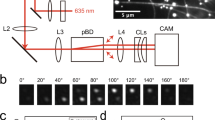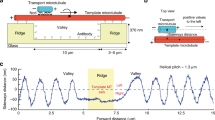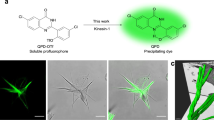Abstract
Kinesin-1 (conventional kinesin) is a dimeric motor protein that carries cellular cargoes along microtubules1,2 by hydrolysing ATP3 and moving processively in 8-nm steps4. The mechanism of processive motility involves the hand-over-hand motion of the two motor domains (‘heads’)5,6,7, a process driven by a conformational change in the neck-linker domain of kinesin8,9,10,11,12. However, the ‘waiting conformation’ of kinesin between steps remains controversial13,14,15,16—some models propose that kinesin adopts a one-head-bound intermediate17,18,19,20,21, whereas others suggest that both the kinesin heads are bound to adjacent tubulin subunits7,22,23. Addressing this question has proved challenging, in part because of a lack of tools to measure structural states of the kinesin dimer as it moves along a microtubule. Here we develop two different single-molecule fluorescence resonance energy transfer (smFRET) sensors to detect whether kinesin is bound to its microtubule track by one or two heads. Our FRET results indicate that, while moving in the presence of saturating ATP, kinesin spends most of its time bound to the microtubule with both heads. However, when nucleotide binding becomes rate-limiting at low ATP concentrations, kinesin waits for ATP in a one-head-bound state and makes brief transitions to a two-head-bound intermediate as it walks along the microtubule. On the basis of these results, we suggest a model for how transitions in the ATPase cycle position the two kinesin heads and drive their hand-over-hand motion.
This is a preview of subscription content, access via your institution
Access options
Subscribe to this journal
Receive 51 print issues and online access
$199.00 per year
only $3.90 per issue
Buy this article
- Purchase on Springer Link
- Instant access to full article PDF
Prices may be subject to local taxes which are calculated during checkout




Similar content being viewed by others
References
Vale, R. D. The molecular motor toolbox for intracellular transport. Cell 112, 467–480 (2003)
Hirokawa, N. & Takemura, R. Molecular motors and mechanisms of directional transport in neurons. Nature Rev. Neurosci. 6, 201–214 (2005)
Hackney, D. D. Evidence for alternating head catalysis by kinesin during microtubule-stimulated ATP hydrolysis. Proc. Natl Acad. Sci. USA 91, 6865–6869 (1994)
Svoboda, K., Schmidt, C. F., Schnapp, B. J. & Block, S. M. Direct observation of kinesin stepping by optical trapping interferometry. Nature 365, 721–727 (1993)
Asbury, C. L., Fehr, A. N. & Block, S. M. Kinesin moves by an asymmetric hand-over-hand mechanism. Science 302, 2130–2134 (2003)
Kaseda, K., Higuchi, H. & Hirose, K. Alternate fast and slow stepping of a heterodimeric kinesin molecule. Nature Cell Biol. 5, 1079–1082 (2003)
Yildiz, A., Tomishige, M., Vale, R. D. & Selvin, P. R. Kinesin walks hand-over-hand. Science 303, 676–678 (2004)
Vale, R. D. & Milligan, R. A. The way things move: looking under the hood of molecular motor proteins. Science 288, 88–95 (2000)
Rice, S. et al. A structural change in the kinesin motor protein that drives motility. Nature 402, 778–784 (1999)
Skiniotis, G. et al. Nucleotide-induced conformations in the neck region of dimeric kinesin. EMBO J. 22, 1518–1528 (2003)
Asenjo, A. B., Weinberg, Y. & Sosa, H. Nucleotide binding and hydrolysis induces a disorder–order transition in the kinesin neck-linker region. Nature Struct. Mol. Biol. 13, 648–654 (2006)
Tomishige, M., Stuurman, N. & Vale, R. D. Single-molecule observations of neck linker conformational changes in the kinesin motor protein. Nature Struct. Mol. Biol. 13, 887–894 (2006)
Carter, N. J. & Cross, R. A. Kinesin’s moonwalk. Curr. Opin. Cell Biol. 18, 61–67 (2006)
Valentine, M. T. & Gilbert, S. P. To step or not to step? How biochemistry and mechanics influence processivity in Kinesin and Eg5. Curr. Opin. Cell Biol. 19, 75–81 (2007)
Hackney, D. D. Processive motor movement. Science 316, 58–59 (2007)
Block, S. M. Kinesin motor mechanics: binding, stepping, tracking, gating, and limping. Biophys. J. 92, 2986–2995 (2007)
Kawaguchi, K. & Ishiwata, S. Nucleotide-dependent single- to double-headed binding of kinesin. Science 291, 667–669 (2001)
Uemura, S. et al. Kinesin-microtubule binding depends on both nucleotide state and loading direction. Proc. Natl Acad. Sci. USA 99, 5977–5981 (2002)
Carter, N. J. & Cross, R. A. Mechanics of the kinesin step. Nature 435, 307–312 (2005)
Auerbach, S. D. & Johnson, K. A. Alternating site ATPase pathway of rat conventional kinesin. J. Biol. Chem. 280, 37048–37060 (2005)
Alonso, M. C. et al. An ATP gate controls tubulin binding by the tethered head of kinesin-1. Science 316, 120–123 (2007)
Asenjo, A. B., Krohn, N. & Sosa, H. Configuration of the two kinesin motor domains during ATP hydrolysis. Nature Struct. Biol. 10, 836–842 (2003)
Hackney, D. D. The tethered motor domain of a kinesin-microtubule complex catalyzes reversible synthesis of bound ATP. Proc. Natl Acad. Sci. USA 102, 18338–18343 (2005)
Woehlke, G. et al. Microtubule interaction site of the kinesin motor. Cell 90, 207–216 (1997)
Kaseda, K., Higuchi, H. & Hirose, K. Coordination of kinesin’s two heads studied with mutant heterodimers. Proc. Natl Acad. Sci. USA 99, 16058–16063 (2002)
Guydosh, N. R. & Block, S. M. Backsteps induced by nucleotide analogs suggest the front head of kinesin is gated by strain. Proc. Natl Acad. Sci. USA 103, 8054–8059 (2006)
Tomishige, M., Klopfenstein, D. R. & Vale, R. D. Conversion of Unc104/KIF1A kinesin into a processive motor after dimerization. Science 297, 2263–2267 (2002)
Sablin, E. P. & Fletterick, R. J. Coordination between motor domains in processive kinesins. J. Biol. Chem. 279, 15707–15710 (2004)
Acknowledgements
We thank M. Nakajima for support in cloning; H. Tadakuma and N. Stuurman for microscope construction and technical support; C. Shingyoji for the gift of sea urchin sperm; K. Kikuchi for the tracking program; and A. Yildiz and A. Carter for discussions. M.T. is supported by Grant-in-Aid for Scientific Research on Priority Areas from MEXT, Japan, a Research Grant for Young Investigators from the Human Frontier Science Program, and grants from the Mitsubishi Foundation and the Asahi Glass Foundation. R.D.V. is supported by grants from the Howard Hughes Medical Institute and the US National Institutes of Health.
Author information
Authors and Affiliations
Corresponding author
Ethics declarations
Competing interests
The authors declare no competing financial interests.
Supplementary information
Supplementary Information
This file contains Supplementary Figures S1-S9 with Legends. (PDF 2069 kb)
Rights and permissions
About this article
Cite this article
Mori, T., Vale, R. & Tomishige, M. How kinesin waits between steps. Nature 450, 750–754 (2007). https://doi.org/10.1038/nature06346
Received:
Accepted:
Published:
Issue Date:
DOI: https://doi.org/10.1038/nature06346
Comments
By submitting a comment you agree to abide by our Terms and Community Guidelines. If you find something abusive or that does not comply with our terms or guidelines please flag it as inappropriate.



